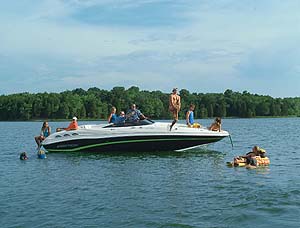How To Pack For A Boating Trip: All Of The Essentials
This handy guide includes the essentials for packing when preparing for a cruising trip on a boat or yacht.
Preparing For A Boating Trip
Packing for a boating trip can feel daunting, given all of the unexpected scenarios associated with boating, but isn't that what makes it an adventure? This handy guide includes all the essentials for packing when preparing for a weekend cruising on a boat or yacht; you may want to customize it based on your specific boat, destination, and personal preferences.

Above: Friends enjoying sunset on a boat. Image via Boatsetter.
Clothing Options
There could be unexpected temperature variations between ports of call and different types of activities and shore excursions. If you are invited on board as a guest, have a full itinerary of activities and restaurants so that you can prepare to dress accordingly. If you are the captain organizing the trip, consider sending a group email to all guests confirming the itinerary so that nobody is caught off guard. Fold or roll, then separate your clothes into categories – shirts, shorts, tank tops, shorts, trousers, bathing suits, and undergarments. Vacuum-packing garments in plastic bags or rolling them up will save space.
Before going on a trip you should check out the marine weather forecast, but be prepared that it's not written in gold and pack for all eventualities. During a day of sailing, your attire will likely consist of bathing suits and a cover-up of some description to protect you from the sun. Pants that have removable, zip-on/off legs so they can be either shorts or long pants might not win any fashion awards, but they are practical and will protect you legs.
Bathing Suits
On board, swimwear will become a second skin. We recommend packing one or two extra bathing suits to avoid that unpleasant feeling of pulling on wet ones. Plus, they take up minimal room in your luggage. If you plan to spend much time in the water, consider investing in a lightweight wetsuit jacket to keep you warm while snorkeling, especially in the early Spring or late Summer months.
Quick-Dry Fabrics
Sunbrella fabrics are known for their breathability qualities. It is worth investing in specialist marine fabrics that dry quickly outdoors, thus preventing any mold from appearing. Buying UV-resistant, windproof and waterproof fabrics will become appreciated as soon the sun is too strong or if there is a case of unexpected inclement weather.
Lightweight Foul Weather Gear
Pack for all eventualities and bring a waterproof jacket and trousers if you have them, just in case the weather is unexpectedly bad.
Footwear
Most yachts will have a no-footwear rule, so pack socks you are happy being seen in. Two matching ones are a good start! If your boat permits you to wear footwear, bring non-slip, comfortable non-slip boat shoes, or flip-flops for on-board use. Avoid bringing heels on board at all costs.
Sailing Gloves
Heavy and thick mooring ropes are often overgrown with shells, and pulling the rope with your bare hands is likely to leave them dirty, or even damaged. If you don't own any sailing gloves cycling gloves will also do the job.
Water and Wind-Friendly Accessories
Pack a hat that won't blow off your head on a windy day to prevent sun exposure. Youconsider purchasing a cheap loose strap to loop sunglasses over your head. A 6" cord with a clip on both ends, one clip to your hat and the other to your collar, is the best option for sailors. Alternatively, use a retainer clip to fix it onto your hat or clothes.
Use A Soft-Sided Bags
Luggage storage space on almost all boats is limited, and hard-sided bags can cause damage to teak decks. Soft duffels can be folded up and stowed after you're unpacked. Avoid bringing a hard-sided suitcase or bag; you won't be able to store it easily.
Fins, Mask and Snorkel
Check whether the yacht you'll be sailing on provides them, and if not, bring your own because diving is a game-changer on the boat since there is always more to see underwater.
Ladies, Bring A Pouch
A cute pouch for my essentials (phone, wallet, cash for the markets, lip balm, etc.) so that you don't have to lug around a big day bag if you stop for lunch.
Beauty Essentials
Reef-safe Sunscreen
Avoid packing oil sunscreens since they stain teak and canvas decks and sunbed cushions. Suntegrity Mineral Sunscreen is the best non-greasy choice in the market. Sun Bum also smells delicious of bananas.
SPF
Invest in an ocean-friendly sunscreen with a minimum of 30. Remember to reapply, mainly when in and out of the water.
Hair Brush, Mask And Comb
For low-maintenance hair, bring a hair mask, a simple detangle brush, and a slick back. Et voila!
Seasickness Remedies
On a windy day, Even people with iron stomachs can fall prey to motion sea sickness, so taking some sickness medication on the morning of the day you board is a good idea because it will give your body a chance to adapt to the boat's motion. The prescription Transderm Scop behind-the-ear patch is famous, but be mindful of possible side effects. Dimenhydrinate, commonly known by the brand name Dramamine, is also another popular over-the-counter option. This is best taken at night because it will likely make you extremely sleepy. Consult your doctor and pharmacist before using any medication.
Earplugs And Eye Masks
If you're a noise-sensitive sleeper, sleeping on a boat can be noisy depending on which port you are berthed in and what night of the week it is. If your boat or yacht does not have blackout blinds, bring an eye mask to block out the light.
Electronics
Ask whether you can recharge your cameras, mobiles, computers, and other electronics onboard. The voltage on board in Europe is 220V, so you will need a converter plug for UK electronics.
Travel Documents
Before leaving home, check the validity of your travel documents. If you are the captain, keep the following documents on hand and in a safe place:
- A skipper's license
- A crew list (if required)
- A VHF radio operator's license
- Insurance company document/number
A Refillable Water Bottle
Between the sun exposure and play time in the saltwater, getting dehydrated on a boat is easy. Taking a large refillable water bottle around is a good reminder to drink. Avoid using single-use plastics on board at all costs.
Toys and Entertainment
There can be a lot of relaxation time on a boat. Contribute to the social scene by bringing a set of dice or a deck of cards on board with you. Word games are a great option, too. In addition to being an excellent way to get to know fellow passengers, you might also learn new games.
Bring a Kindle or a book on board; there is no better place to read than on the deck of a boat since there are no distractions around you, only the gentle lull of waves rocking you back and forth.
Galley and Food
Check with the captain or whoever is organizing the crew that they have everything they need, from cooking and eating utensils to food and drinks, including non-perishable items, plenty of snacks and a cooling device. You should have enough food and water supplies on your boat for at least three days (even if you plan to dine mostly in restaurants).
Useful Extras
- Laundry pegs. Ideal for long periods at sea in the high season
- Waterproof cases for documents, tablets and mobile phones.
- Pack an extra towel
Health And Safety
If you are the captain, or organizing the trip you are responsible for making sure that everybody onboard has a lifejacket and a whistle. Here are the must-haves for any boating trip.
- First-aid kit.
- Flashlights with extra batteries.
- Life jackets (1 per person)
- Throwable life ring and boat hooks.
- VHF radio and binoculars.
- Extension cord
- Headlamps (with red light since eyes adjust faster to a red light at night.
One Final Top Tip
Fill your soft-sided bag with everything you need, then reduce it by half.
The most common mistake people make packing for their first cruising trips is bringing too many belongings on board. Unless you are on a very formal charter where there might be dress codes to adhere to, the boating lifestyle is more laid back, and the dress code is casual, especially in tropical or temperate-weather locales.
Get Boat Ready
After a long, cold winter in the upcoming months, you could begin to Get Your Boat Ready: Spring Commissioning Checklist where you can find a checklist of essential commissioning items to help you get underway, with the complete explanation and tips for each below:
- Commissioning Hull, Topsides, and Decks
- Commissioning Mechanical Systems
- Commissioning Plumbing Systems
- Commissioning Boat Trailers
- Safety Gear Checks
- Miscellaneous Gear Checks
If you are planning to go a little further offshore, another useful guide you should check out is How to Prepare a Yacht for Offshore Sailing












